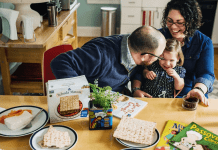My husband and I have walked into my late mother-in-law’s house for the last time.
We are in the process of settling her estate, including the sale of her house and disposition of everything in it.
From a hutch filled with china and crystal goblets to overflowing jewelry boxes and coin collections. And everything in between.
A lot in between.
Her clothes. The Notre Dame sweaters my late father-in-law was so fond of wearing. Her furniture. Furniture inherited from her mother-in-law, still in the same place in the garage where it was originally placed 30 some-odd years ago. My husband’s Cub Scout uniform. Christmas decorations. Lots and lots of Christmas decorations.
Every room, every closet, every shelf, every drawer. Full of stuff. A lifetime of stuff. Two lifetimes, if you count my father-in-law, who passed away 11 years ago.
What to Do With a Lifetime of Stuff
My mother-in-law was a neat and tidy housekeeper. But like many of us (myself included), she lived in a good-sized house with plenty of room to accommodate stuff. Things inherited from her parents and her in-laws. The broken vacuum cleaner waiting for repair in the back of the closet. Hundreds of books read once. You get the picture.
And the cost of disposing of all of that stuff? Having the estate sale company we hired go through every room, every closet, every drawer, separating the trash from the treasures, may cost more than will be generated at the eventual estate sale.
Her house has been transformed into a store, the estate sale company having cleverly arranged and displayed my mother-in-law’s possessions on tables in every room.
All of her possessions with any value, save the very few we kept, each with a tiny white price tag.
Losing your last surviving parent is hard enough. But being the arbiter of which of your parents’ and grandparents’ treasures get saved and which end up sold, donated, or in a landfill? gut-wrenching.
The lesson we have learned from this experience?
Most of the stuff in your house is worthless. And eventually, someone, either you or your kids, will be tasked with the overwhelming job of getting rid of it.
Most of Your Stuff Is Worthless
Most of the stuff in your house is worthless.
Yes, even the stuff you worry the most about, the stuff you think is so good you don’t use it for fear of breaking it, has little to no resale value.
From china, china cabinets, crystal goblets, silver tea sets, pianos, and collectible figurines like Hummels, to grandfather clocks and real pieces of craftsmanship furniture.
Why? Baby boomers have glutted the market with their castoffs, and millennials, the next generation of buyers, don’t want it.
Millennials hate both formal in-home entertaining and use of second-hand goods. With looming student loans, they tend to rent and move often. Who wants to be constantly moving a piano and a grandfather clock from apartment to apartment?
And furniture? There’s no market for so-called “brown furniture,” meaning any furniture (regardless of quality) other than the “mid-century casual” furniture (think clean, lightweight) favored by millennials. Brown furniture is basically firewood.
If it’s not in great condition, it’s also not fit for donation because it can’t be resold.
All of my mother-in-law’s furniture (including the pieces inherited from her mother-in-law and kept for decades)? Straight to the landfill.
Well, Almost Everything…
What do guns, LPs (records), and precious metals/gems have in common?
They are 3 things you might have in your house with a robust resale value.
Silverware also has value, but only if it is real silver and can be melted down.
3 Things You Should Be Doing NOW to Reduce the Amount of Stuff You Have
1. Be viciously thoughtful about holding onto sentimental items.
Here was our goal with sorting through my mother-in-law’s things. Keep just enough to remind us of her, but not so much stuff that our daughters are going to be dealing with it 40 some-odd years from now.
Here’s what we kept:
- A painting to be displayed in our dining room
- My mother-in-law’s treasured Swarovski crystal animal collection (all of which were given to her by her children and grandchildren over the years)
- Jewelry to be divided among the granddaughters
- Each of our daughters got to select 1 item
And that was it.
Well, almost. We did set aside photos to be digitized (with the originals then destroyed).
Was it hard leaving everything else? You bet it was. But we don’t want to be dealing with a lot of stuff years from now (or worse, leaving it to our daughters to deal with).
I try to be viciously thoughtful with my own sentimental items. For example, I don’t save any school papers or art projects from my kids (though I do take photos of my favorites).
2. Buy fewer books.
While used book resellers like Half Price Books do an important service in keeping books in circulation, a surprising number of books end up in landfills because many paper recycling facilities can’t process the the glue that binds book spines.
My resolution last year was to cut down on my book consumption by only reading books that I borrow from the library or purchase on my Kindle e-reader. If you haven’t used a library in years, now is the time to go back. My local library has an app where you can “order” books online, and pick them up the next day on a special “hold” shelf strategically placed next to the check-out kiosk.
How successful was I on my resolution? I read 1 to 2 books a week in 2019, only 1 of which was a hard copy purchased from Amazon.
3. Buy fewer, but better quality, clothes
The world is overflowing with used clothing.
We buy substantially more clothing over our lifetimes than our grandparents did.
Clothing made today is meant to last no more than a few years. In fact, a lot of clothing isn’t even made to withstand more than a few washes.
Think you are “paying it forward” but dropping off a load of unwanted clothes at Goodwill? Think again. Most clothing donations never make it to the racks at Goodwill and only about a third of what does eventually sells.
To really pay it forward, cut down on the amount of clothing you have by buying better quality clothes that last longer.
Keeping What Really Matters
My 5-year-old chose to keep a Christmas music box from her Grandma’s house. It plays “White Christmas” and has tiny ice skaters going around a rink inside. Each Christmas, my mother-in-law would bring out this music box and let each of her granddaughter’s play with it. It’s value in preserving a precious memory of Grandma? Priceless.














I am a boomer and am fortunate that my millenial son loves vintage items. That includes my antique (brown, not painted!) furniture, MCM collections, and everything in-between. Last year my 83-yr-old aunt sold a lot of her stuff online. People paid good prices for these things. I treasure the things that have been passed down to me, and there will always be people who feel the same way!
Cloths the Goodwill don’t sell are sold to Ragmen. Ragmen buy the unsold Goodwill clothing to be sold to factories that make plush Turkish bath towels, which are sold to oil companies. Oil companies use them to soak up spills on offshore drilling rigs.
This may sound preposterous, but it’s true. My mother was a buyer for Continental Emsco, a division of Standard Oil. She purchased multiple thick, plush towels.
Can’t believe this author recommending people digitize all photos then destroy the the hard copy.
Millennials don’t buy furniture because they don’t have any money and/or move back home with their parents after college.
Guess I’ve got a lot of junk supposedly but I do plan to get rid of it and not leave a lot of junk for my kids to deal with like I had to with my mom
But yup milleneals don’t want China silver etc
Maybe jewelry if can be sold that’s it
You destroyed all the photos?! And what happens when those digitized photos all get corrupted, or whatever/wherever they’re stired crashes? You no longer have all the memories. Pictures are sacred, not something to just be scanned and thrown away. Furniture? Good furniture that may just need refurbished? Same. But I’m not a Millennial, I’m at the end of Gen. X. Plus my family, even my younger cousins, we’ve all been raised to appreciate the things our parents, grandparents, etc. have. Maybe if people would quit raising their kids that stuff is disposable, things would change.
I know this is true. Been there. Twice. But I studied furniture and find some of the best to be worth far more than when purchased. Bench made mahogany, cherry, and walnut, just can’t be replaced. Especially Carolina furniture. Rare and still selling used as new is made from cardboard.
But I needed to read this and know it is really good advice.
Clothing and jewelry of today look trashy and pretty ugly. Also, no one wants China, crystal, or dining furniture. Lastly, because of that, you definitely need to throw out the etiquette books.
No one has proper manners today!
I’m so grateful to have been a boomer and lived aim a gentler and kinder world.
What a shame to assume that the generation after your children will have zero interest in family heirlooms. We cannot predict the future – and these things do go in cycles. I predict that after this current generation that the next one will long for items that were once owned by their grand and great-grandparents. Not a ton of them – you have a point there! But some.
I do also agree with you about owning fewer and better quality clothing.
There are still people out there who want – and need – furniture (of any kind, including “brown” furniture. Especially people rebuilding their lives (newly released from prison, rescued from sex trafficking, single mothers, the homeless who get help to get off the street, etc.) those of you reading this please try to find the ministries that help those folks I’m mentioning to set up a home when they have zero. There are children sleeping on the floor in my city because their parent just got out of prison (or jail) and were given their children back, but they have no furniture, especially no beds. Please don’t send furniture to the landfill before checking with the programs and ministries that are helping the poor.
I have recently moved and in my 70s, wow I don’t like saying that because I don’t feel like I am, anyway after moving I find that I need to dispose of things I don’t need any longer, I don’t know what to do with them I’m at the stage, and I don’t want my kids to have to deal with it all when I’m gone, but I really don’t have anywhere to dispose of it and can’t bring myself to send it to the tip, I would need help which I don’t have to do a garage sale, but to organise things to have a garage sale feels all to hard. So everything stays put for now….. I’m afraid that it why so many just don’t get rid of everything and it is left for the family to deal with.
Your absolutely right, but in some continents like Africa..such things can be turned in to value. Like many people don’t have furniture, clothes etc..and any donation to them can make sense.
My “better clothes” are usually bought at thrift stores, like Lee Rider jeans for &1.99- $4.99 a pair! We just moved into my mother-in-law’s house- it is now deeded to my husband and me. We are staying with her because she will soon be 91. The house was completed in 1850. I am excited to be able to live here- it’s an antebellum style home with the columns and balcony on the front, 14 foot ceilings and a fireplace in every room. There is ornate plaster fretwork, hand done by a master craftsman from France in the dining room, front hall and parlor, along with a mahogany staircase in the hallway. Yes, it has beautiful “brown furniture “ that will outlast us! It has a civil war history, and our family has a “reinactment” of that history every April. We host the immediate family- around 12-15, after church every Sunday for lunch, and the extended family, which can be up to 30, for Thanksgiving. We cherish the “old stuff” here because it has a history, including the China, crystal and silver! And finding old pictures and newspaper clippings is exciting because we learn a bit more about family that lived here before us. I guess it’s different in other parts of the country where people rent and move about and don’t put down roots for their families. Sad.
I love this post.